 by "ttyymmnn" (ttyymmnn)
by "ttyymmnn" (ttyymmnn)
Published 09/01/2017 at 12:35
 by "ttyymmnn" (ttyymmnn)
by "ttyymmnn" (ttyymmnn)
Published 09/01/2017 at 12:35
Tags: Planelopnik
; planelopnik history
STARS: 17
Welcome to This Date in Aviation History , highlighting milestones, important historical events and people in aviation and spaceflight from August 30 through September 1.
!!! UNKNOWN CONTENT TYPE !!!
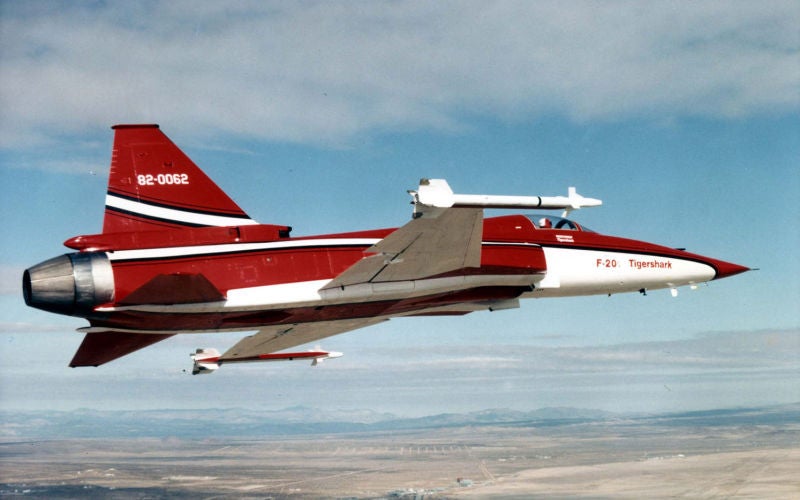
August 30, 1982 – The first flight of the Northrop F-20 Tigershark. When the Northrop Corporation first flew the F-5 Freedom Fighter in 1959, they were bucking a trend. Fighters had become ever more complex—and expensive—and Northrop’s little hot rod would set the bar for capable fighter aircraft that were effective over the battlefield but not prohibititvely expensive to operate or to service. The F-5 became an excellent low-cost export for nations friendly to the US and eventually saw service in 31 nations. But by the late 1970s, restrictions put in place by the US government prohibited the export of the latest American fighter planes for fear that American technology might fall into enemy hands. So the US needed a new simple yet powerful fighter to take on the role that had been filled by so well by the F-5. Thus began the Air Force’s FX program, and both Northrop and General Dynamics responded. Northrop presented the F-5G, a further modernized and upgraded version of their venerable little fighter, and General Dynamics proposed the F-16/79 , a downgraded version of the F-16 Fighting Falcon currently in production for the US Air Force. It looked like Northrop might have gotten its timing just right to fulfill the expected windfall of export orders, but political waffling in the US Congress and changing export guidelines eventually permitted General Dynamics to export the F-16, along with its advanced technology. Northrop needed to improve the F-5G to match the F-16’s performance in the hopes of winning an export contract. Part of that upgrade took the form of a change in branding. Many still saw the name “F-5" as denoting an inexpensive, second-tier aircraft meant for developing countries. So Northrop lobbied the Air Force to change the designation to F-20, and added the nickname Tigershark. To increase performance, the F-20 was fitted with the same General Electric F404 afterburning turbofan that was developed for the YF-17 , which gave the fighter a 60% improvement in thrust over the F-5G.
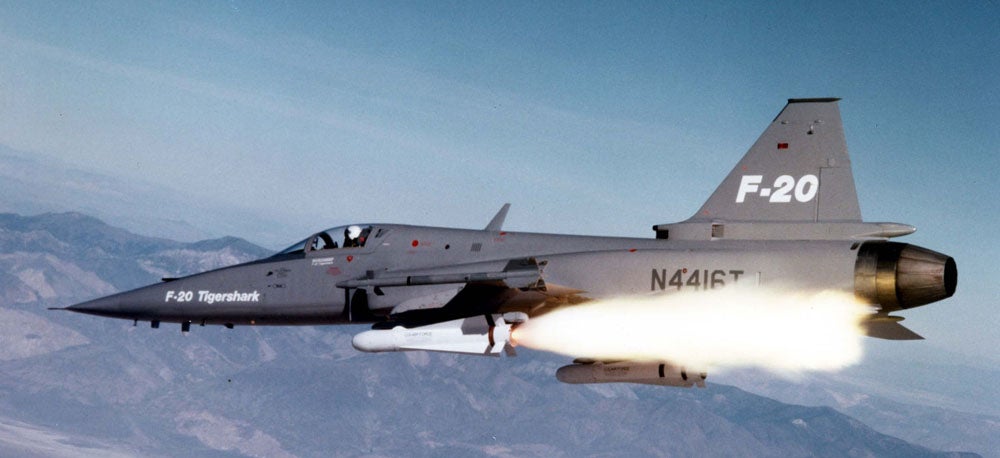
It was also fitted with updated avionics and the ability to fire beyond-visual-range AIM-7 Sparrow air-to-air missiles, a capability that the F-16 was not able to match. Testing of the new fighter progressed admirably, and the Tigershark proved to be a formidable aircraft, providing at least as much punch as the F-16 but at a significantly lower cost. It’s single engine gave it a top speed of Mach 2, and it was armed with a pair of Pontiac M39A2 cannons in the nose and 5 external hardpoints for a wide range of rockets, missiles and bombs. Ultimately, though, the F-20 proved to be a case of an excellent aircraft with tragically bad timing. With no support from the US government, changing export restrictions that favored the F-16, and a lack of any international buyers after most opted for the more advanced F-16, the F-20 was eventually canceled in 1986 after only three aircraft had been produced. Two of the prototypes were lost to crashes, and the third now resides at the California Science Center in Los Angeles. (US Air Force Photo)
!!! UNKNOWN CONTENT TYPE !!!
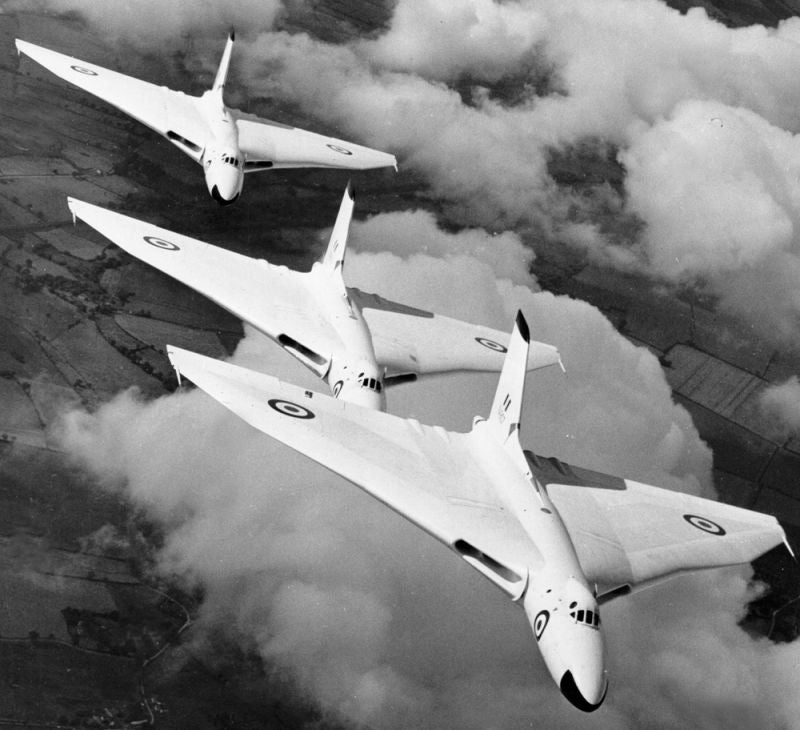
August 30, 1952 – The first flight of the Avro Vulcan. With the widespread adoption of the turbojet engine by the end of WWII, military planners moved quickly to incorporate the new powerplant into their strategic and tactical bomber fleets. In England, development of new aircraft was also closely tied to their nascent nuclear weapons program, which began to take shape in 1947. But the British Air Staff was working to stay ahead of the government, and had issued Specification B.35/46 the previous year that called for the creation of a new strategic bomber that would have four jet engines, a cruising speed of 500 knots and a ceiling of at least 55,000 feet. Two aircraft manufactures answered the call, Handley Page and Avro , with each making a unique aircraft that would eventually complement each other and ended up serving side by side for many years. Handley Page designed their swept-wing Victor , which served as a bomber, reconnaissance aircraft and aerial tanker until 1993, while Avro developed the Vulcan. Along with the Vickers Valiant , these three aircraft were known as the V Bombers , and the types reached their heyday in the 1960s before slowly being supplanted by ballistic missiles and smaller aircraft with tactical nuclear munitions. The Vulcan was one of the earliest planes to make use of the new delta wing and, though delta wing designs matured later in the decade of the 1950s, their use was still novel and untested. To make sure their bomber would work, Avro started out with a series of scale models to prove the concept. The first was the single-seat Avro 707 which first flew in 1949. While that aircraft crashed, killing the pilot, more models of the 707 followed which solved the problems of handling and resulted in a very stable aircraft. These scale tests continued until 1952, when Avro flew their full-sized bomber for the first time. But concerns about the design remained, and the British government ordered the production of the Valiant in the event that the Vulcan was a failure. Those fears proved to be unfounded, and the Vulcan turned out to be an extremely stable and capable aircraft. After ironing out a few remaining issues, the B.1 model entered service in 1956, and the B.2, with a redesigned wing and more powerful engines, entered service in 1960.
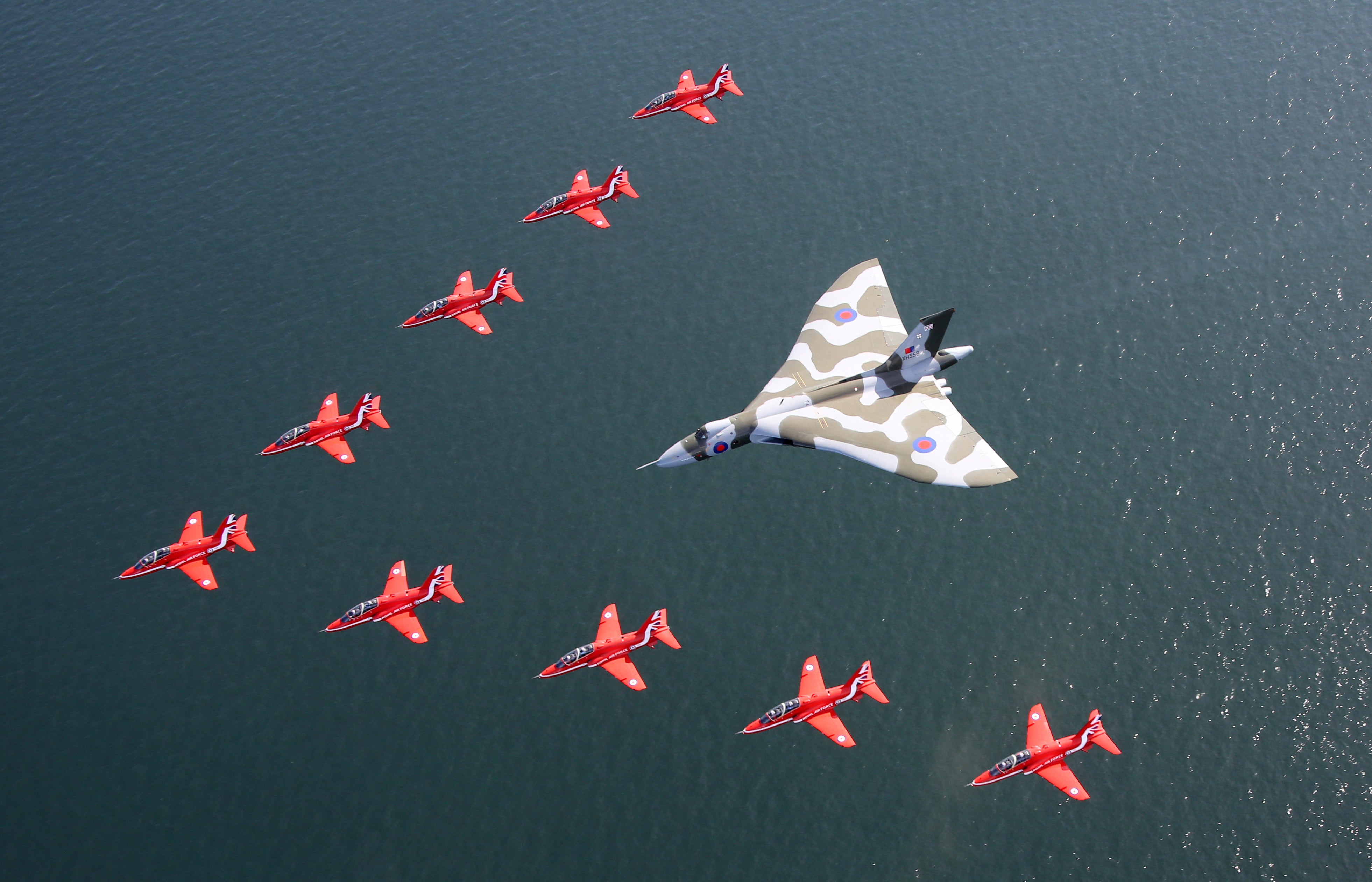
The Vulcan was originally conceived as a long-range nuclear deterrent, and its range was demonstrated during a round-the-world tour soon after the aircraft entered service. Aerial refueling capabilities were also added to further increase range. While the Vulcan was never called upon to perform its nuclear mission, the bomber was also capable of carrying up to 21,000 lbs of conventional bombs. Vulcans saw their first and only combat action in the
Falklands War
in 1982, flying from tiny Ascension Island in the middle of the Atlantic Ocean to bomb Argentine forces, making an 8,000 mile round trip. Avro produced a total of 136 Vulcans from 1956-1965, and they were retired by the RAF in 1984.
(RAF photos)
!!! UNKNOWN CONTENT TYPE !!!
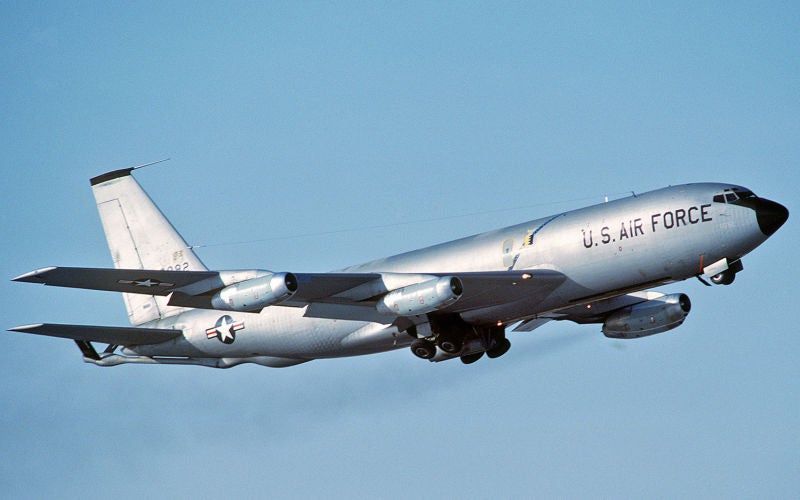
August 31, 1956 – The first flight of the Boeing KC-135 Stratotanker.
One of the earliest successful, and even remotely practical, experiments with aerial refueling occurred in 1923, when one US Army Air Forces
Airco DH-4
biplane refueled another through a hose draped between the two aircraft. America’s first dedicated strategic tanker, a variant of the
Boeing C-97 Stratofreighter
, entered service in 1951 but, as the US Air Force entered the jet age, it quickly became apparent that propeller-powered aerial tankers were not fast enough to keep up with the new jet-powered fighters and bombers. In 1954, the Air Force announced its intention to procure a modern tanker/transport aircraft to replace the KC-97, and both Boeing and Lockheed competed for the contract. Lockheed proposed the
L-193 Constellation II
, a design with two rear-mounted engines, and Boeing offered a version of their
367-80
, better known as the Dash 80, a proof-of-concept aircraft that would also be developed into the the
707
. Though the Lockheed design was declared the winner, their aircraft was still on the drawing board while the Boeing design was already flying and could be delivered two years ahead of the L-193. So the Air Force changed its mind and selected the Boeing design, which they designated the KC-135 (Boeing initially gave the aircraft the designation 717, and it actually predates the civilian 707 airliner). Though the KC-135 and 707 look very similar, the KC-135 is shorter and narrower than its airliner sibling though, at least initially, they were both powered by the same
Pratt & Whitney J57
(P&W designated the engine the JT3C) axial flow turbojet engines. Acting as both an aerial refueler and a cargo plane, the KC-135 could carry more than 31,000 pounds of fuel, a dramatic increase over the 14,900 pounds carried by the KC-97, and could accommodate up to 83,000 pounds of combined fuel and cargo.
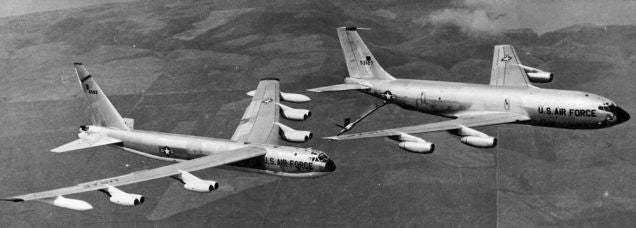
In the strategic refueling role, the Air Force expected the KC-135 to provide refueling for long-range
Strategic Air Command
(SAC) bombers such as the
Boeing B-47 Stratojet
and
Boeing B-52 Stratofortress
. However, during the Vietnam War, the Air Force (and US Navy and US Marine Corps) learned that having tankers on station near the battlefield could dramatically extend the loiter time of fighters and attack aircraft. Planes that could once only spend minutes over a target could now stay for hours with aerial refueling. So the KC-135, which was originally fitted with the
flying boom
refueling probe used by Air Force aircraft, was modified to support the
probe-and-drogue
system in use by the Navy and Marine Corps. The Stratotanker has been continually upgraded throughout its service life, receiving more powerful and fuel efficient engines and improved avionics, and it provides refueling services the world over to this day. In ten years of production from 1955-1965, Boeing built just over 800 KC-135s, and it was exported in small numbers to Chile, France, Singapore and Turkey. In current service, the strategic refueling role has largely been supplanted by the larger
McDonnell Douglas KC-10 Extender
, while the KC-135 has taken on the tactical refueling role. The KC-135 is also one of only a small handful of aircraft to log over 50 years of service. Starting in 2018, the KC-135 will begin to be replaced by the
Boeing K-46 Pegasus
, which is a development of the
Boeing 767
airliner.
(US Air Force photos)
!!! UNKNOWN CONTENT TYPE !!!
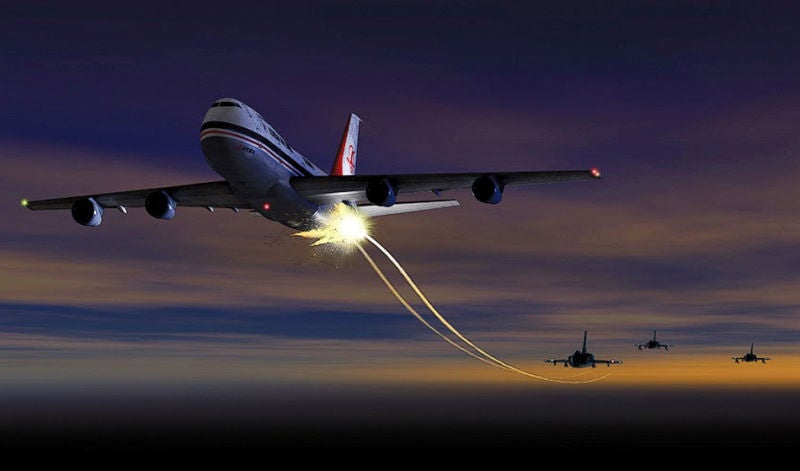
September 1, 1983 – Korean Air Lines Flight 007 is shot down by Soviet fighters.
Following the end of WWII in 1945, the United States and the Soviet Union, allies in the fight against Hitler’s Germany, quickly became ideological enemies, starting a
Cold War
that would last for more than forty years. In the era before reliable spy satellites, the Soviet Union and America used aircraft to keep watch on each other, and a number of American aircraft were
attacked
or shot down by Russian fighter jets to keep prying eyes away from Soviet airspace. But even in an age of modern satellites, the Russians remained on edge about aircraft intruding into their airspace, and even went so far as to shoot down a civilian airliner that they believed was on a covert spy mission. Korean Air Lines Flight 007 was a scheduled
Boeing 747
(HL7442) flight from New York City to Seoul, South Korea, with a stop in Anchorage, Alaska. Onboard were 246 passengers and 23 crew, along with US Congressman
Larry McDonald
of Georgia, who was on his way to South Korea for a ceremony recognizing the anniversary of the mutual defense pact signed between South Korea and the US. After departing from Anchorage, Flight 007 headed towards South Korea on North Pacific (NOPAC) route Romeo 20 (R-20), which would take it within 17.5 miles of Soviet airspace off the
Kamchatka Peninsula
. Ten minutes after takeoff, Flight 007 began to divert from its intended flight path, most likely due to an improperly set autopilot system. The pilots failed to monitor their position, placing them on a course to cross the southern end of the Kamchatka Peninsula near the city of Petropavlovsk, home to the Soviet Union’s largest Pacific submarine base during the Cold War.
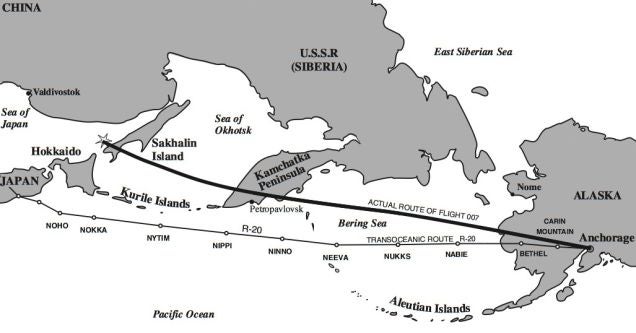
At the time of the shoot down, tensions between the US and Russia were at a height not seen since the Cuban Missile Crisis in 1962. The US was was increasing their anti-Soviet military posture, and were developing the Strategic Defense Initiative (SDI, popularly referred to as Star Wars) to protect the US from nuclear missiles, attempting to stage Pershing II ballistic nuclear missiles in Europe that could reach Moscow in just 10 minutes, and carrying out a huge naval exercise, FleetEx 83, in the north Pacific. Soviet General Secretary Yuri Andropov was convinced that the US was planning a preemptive nuclear strike, and the Russian military was on high alert. Soviet defense radars detected and tracked Flight 007 as it approached Russian airspace, and Sukhoi Su-15 and Mikoyan-Gurevich MiG-23 fighters were dispatched to intercept it. After much confusion and discussion among Soviet military brass, the order was given to shoot down the airplane, whether it was civilian or not. One of the Su-15s maneuvered behind the airliner and fired two K-8 air-to-air missiles, which damaged the hydraulic systems of the airliner and caused the cabin to depressurize. The pilots fought to control the plane, but it eventually spiraled into the water near Moneron Island in the Sea of Japan, killing all on board. Initially, the Russians said nothing about the shoot down, believing that their role could not be proven. Eventually, they admitted to downing the airliner, alleging that it was part of a planned intelligence gathering mission, and suggesting that the fighter pilots had mistaken the airliner for a Boeing RC-135 reconnaissance plane, one of which actually was operating in the area at the time. While all indications are that it was a simple mistake of navigation, many questions linger over the real story of Flight 007. Driven mostly by the inability to find the bodies of the passengers, a host of theories persists, from a purposeful course deviation to monitor the Russian response to a forced landing and the incarceration of the passengers and crew. Others suggest that it was part of a massive, unreported aerial battle between the US and Russia. Following the disaster, the US, Japan and the Soviet Union began to cooperate on radar tracking of aircraft in the north Pacific, and President Ronald Reagan announced in 1983 that the Global Positioning System (GPS) would be made available for civilian use. (Illustration author unknown, via ; map by NASA)
!!! UNKNOWN CONTENT TYPE !!!
!!! UNKNOWN CONTENT TYPE !!!
!!! UNKNOWN CONTENT TYPE !!!

August 30, 1984 – The first flight of Space Shuttle Discovery , the third of five Space Shuttles put in service by NASA. Discovery’s first flight, STS-41-D , took off from Kennedy Space Center in Florida and returned to Edwards Air Force Base in California six days later after deploying a commercial communications satellite and performing scientific experiments. Discovery went on to serve for 27 years and spent a total of 365 days in space while completing 39 missions, including the placement of the Hubble Space Telescope into Earth orbit. In all, Discovery traveled 149,000,000 miles and completed 5,830 orbits. Discovery was retired after its final mission in 2011 and is now on display at the Smithsonian’s Steven F. Udvar-Hazy Center in Virgina. (NASA Photo)
!!! UNKNOWN CONTENT TYPE !!!
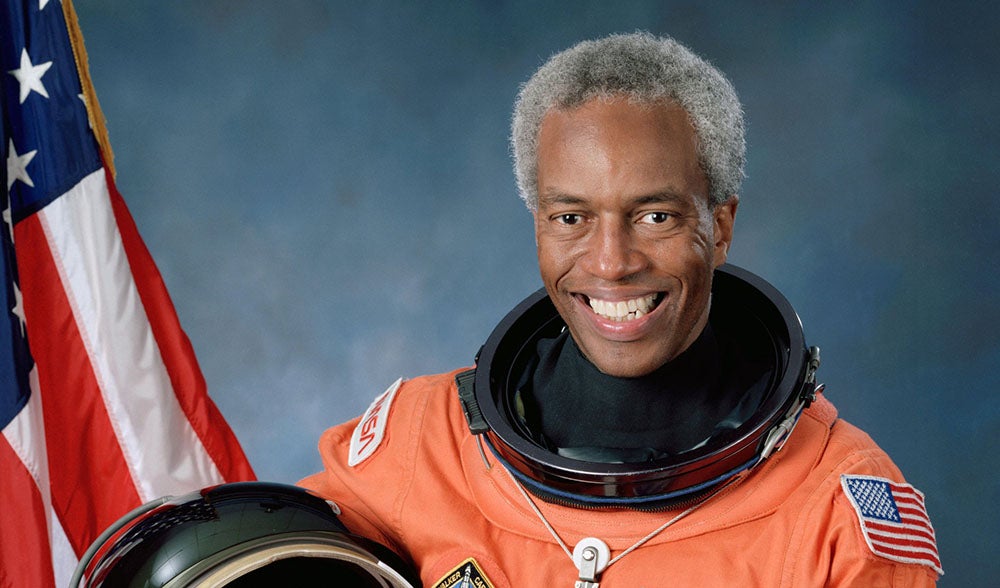
August 30, 1983 – Guion “Guy” Bluford becomes the first African American to fly in space. Born on November 22, 1942 in Philadelphia, Pennsylvania, Bluford obtained a degree in aerospace engineering from Pennsylvania State University and a master’s degree and PhD in aerospace engineering from the US Air Force Institute of Technology. He flew 144 combat missions in Vietnam, served as a flight instructor, and was chosen for the NASA astronaut corps in 1979. Buford flew in space for the first time onboard the Space Shuttle Challenger on STS-8 , the first Shuttle to both launch and land at night. With three other flights on STS-61-A , STS-39 and STS-53 , Bluford spent a total of 688 hours in space. He retired from NASA in 1993, and was inducted into the International Space Hall of Fame in 1997 and the United States Astronaut Hall of Fame in 2010. (NASA photo)
!!! UNKNOWN CONTENT TYPE !!!
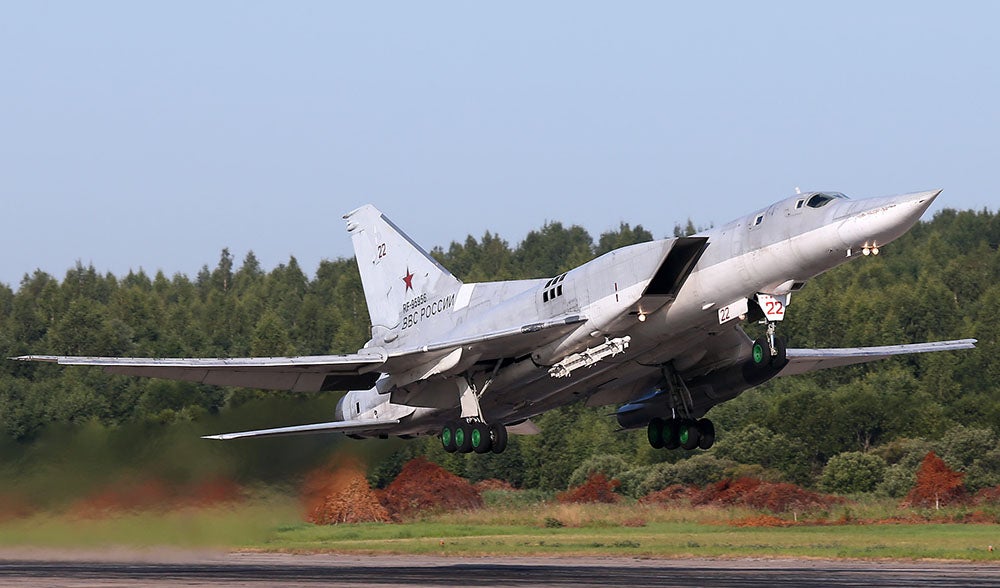
August 30, 1969 – The first flight of the Tupolev Tu-22M, a long-range supersonic bomber and maritime bomber. Powered by a pair of Kusnetsov NK-25 turbofans, the Tu-22M, NATO reporting name Backfire, is capable of a maximum speed of Mach 1.8 and employs a swing wing for high-speed flight. Developed from the notoriously poor Tupolev Tu-22 , the Backfire first became known to the West through satellite photos taken in 1970. It was unveiled in 1980, and soon began simulated attack missions against NATO naval forces. It made its first combat appearance over Afghanistan in 1987, where it served until 1989, and more recently flew in support of the Syrian government in 2015, missions which continue to this day, though it continues to suffer from poor construction and maintenance difficulties. A total of 497 were built from 1967-1997. (Photo by Dmitriy Pichugin via Wikimedia Commons )
!!! UNKNOWN CONTENT TYPE !!!
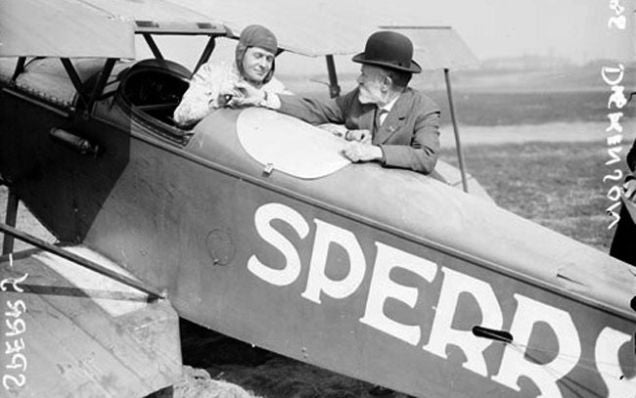
August 30, 1913 – American inventor Lawrence Sperry successfully demonstrates the first autopilot. Developed by the Sperry Coropration in 1912, the first autopilot was a gyroscopic stabilizing device that hydraulically controlled the aircraft’s elevators and rudder and was capable of keeping a plane level and on a compass course, thus greatly relieving pilot workload on long flights. Lawrence Sperry demonstrated his autopilot in Paris in 1914, flying while holding his hands in the air to show that the autopilot was in fact in control of the aircraft. The first autopilots were used on American military aircraft by 1930 and, in 1947, a US Air Force Douglas C-54 Skymaster made the first transatlantic flight, from takeoff to landing, completely controlled by the autopilot. (Chicago Daily News photo via Wikimedia Commons )
!!! UNKNOWN CONTENT TYPE !!!
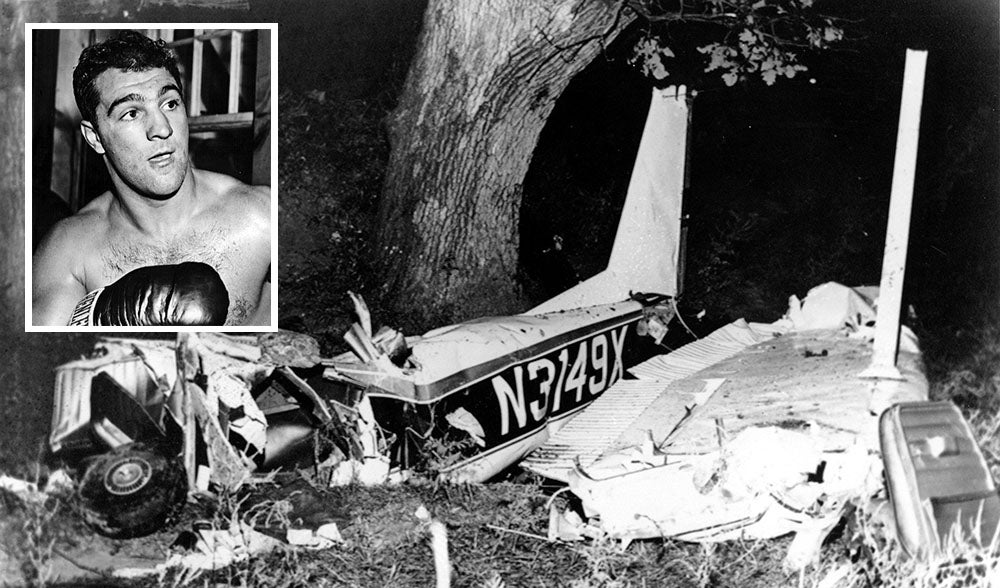
August 31, 1969 – World heavyweight champion boxer Rocky Marciano is killed in a plane crash. Marciano had retired from professional boxing in 1955, having gone undefeated in his career and successfully defending his title six times. The day before his birthday in 1969, Marciano, along with Frankie Farrell, son of boxer Lew Farrell, were passengers in a Cessna 172 (N3149X) flown by pilot Glenn Belz. Belz was a relatively novice pilot, with only 231 total flying hours and just 35 hours of night flying. While flying from Chicago to Des Moines, Iowa at night and in poor weather conditions, Belz, who did not possess an instrument flight training certification, tried to land at a small airfield near Newton, Iowa but struck a tree two miles short of the runway, killing all three on board. The National Transportation Safety Board cited the pilot’s inexperience and the continued use of visual flight rules (VFR) in instrument flight conditions (IFR). (Crash photo via Associated Press; Marciano photo author unknown via Boxing News )
!!! UNKNOWN CONTENT TYPE !!!

August 31, 1965 – The first flight of the Aero Spacelines Super Guppy,
a wide-body, oversize cargo carrier and successor to the
Aero Spacelines Pregnant Guppy
. The Super Guppy was built on the fuselage of a
Boeing C-97J Turbo Stratocruiser
, the military version of the
Boeing 377 Stratocruiser
. Upgraded
Allison T56
turboprop engines allowed the Super Guppy to carry a load of 54,000 pounds at 300 mph, and it was used notably for transporting large sections of the
Apollo
spacecraft. Only one Super Guppy was built before further developments led to the Super Guppy Turbine, of which four were built.
(NASA Photo)
!!! UNKNOWN CONTENT TYPE !!!

August 31, 1958 – The first flight of the North American A-5 Vigilante, an all-weather, carrier-borne, supersonic nuclear strike aircraft designed for the US Navy to replace the Douglas A-3 Skywarrior . Despite its intended role as a nuclear bomber, the Vigilante performed predominately in the role of conventional tactical strike and reconnaissance as the RA-5C, seeing extensive action in the Vietnam War. With a crew of two, the Vigilante was one of the largest aircraft ever to operate regularly from a US carrier, and was retired in 1979 as multi-role fighters took over its reconnaissance and strike missions. (US Navy Photo)
!!! UNKNOWN CONTENT TYPE !!!
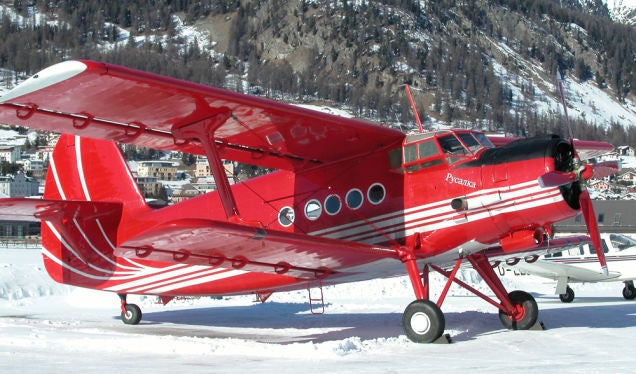
August 31, 1947 – The first flight of the Antonov An-2, a jack-of-all-trades biplane produced in large numbers by the Soviet Union. Over 18,000 copies of this rugged, single-engine biplane have been built since production began in 1947 and, when production ceased in 2001, it marked the end of a 54-year production run surpassed only by the Lockheed C-130 Hercules . The An-2 saw combat during the Korean War, but it exists today in a host of variants for all manners of reconnaissance, utility, agricultural top dressing, and survey work, just to name a few of its uses. Antonov further developed the biplane into the An-3 , with a turboprop engine replacing the radial engine, though only 25 were built. (Photo by Roeme via Wikimedia Commons )
!!! UNKNOWN CONTENT TYPE !!!

September 1, 1948 – The first flight of the Saab J-29,
Sweden’s second turbojet fighter following the
Saab 21R
and the first Western European fighter to be built with a swept swing following WWII. Nicknamed
Tunnan
(
Barrel
), the J-29 was, despite its ungainly appearance, a highly effective and agile fighter that served the Swedish Air Force for over 25 years before its retirement in 1976. The J-29 was powered by a single Svenska Flygmotor RM 2B turbojet (a license-built
de Havilland Ghost
) that gave it a maximum speed of 660 mph, and it was armed with a four 20mm cannons as well as rockets or air-to-air missiles. A total of 661 were produced from 1948-1956, and it was retired in 1976.
(Photo by John5199 via
Wikimedia Commons
)
!!! UNKNOWN CONTENT TYPE !!!
!!! UNKNOWN CONTENT TYPE !!!
!!! UNKNOWN CONTENT TYPE !!!
!!! UNKNOWN CONTENT TYPE !!!
!!! UNKNOWN CONTENT TYPE !!!
!!! UNKNOWN CONTENT TYPE !!!
!!! UNKNOWN CONTENT TYPE !!!
If you enjoy these Aviation History posts, please let me know in the comments. And if you missed any of the past articles, you can find them all at Planelopnik History . You can also find more stories about aviation and aviators at Wingspan and Planes You’ve (Probably) Never Heard Of .
!!! UNKNOWN CONTENT TYPE !!!
 "X37.9XXS" (x379xxs)
"X37.9XXS" (x379xxs)
09/01/2017 at 12:56, STARS: 0
The Vulcan also starred in two (that I know) books

and

And a very important supporting role in a popular movie
!!! UNKNOWN CONTENT TYPE !!!
 "WilliamsSW" (williamssw)
"WilliamsSW" (williamssw)
09/01/2017 at 17:15, STARS: 1
The V-bombers are all very cool — and the Vulcan is the best looking of the group, I think.
And long live the KC-135- -
 "ttyymmnn" (ttyymmnn)
"ttyymmnn" (ttyymmnn)
09/01/2017 at 17:32, STARS: 1
The 135 will be around for a while. Don’t worry.
 "WilliamsSW" (williamssw)
"WilliamsSW" (williamssw)
09/01/2017 at 17:56, STARS: 1
I’ve got a relative who flew them for a long time (out of Scott AFB, I think?)- - he left the military a few years ago and flies for Southwest now.
 "e36Jeff now drives a ZHP" (e36jeff)
"e36Jeff now drives a ZHP" (e36jeff)
09/05/2017 at 11:36, STARS: 0
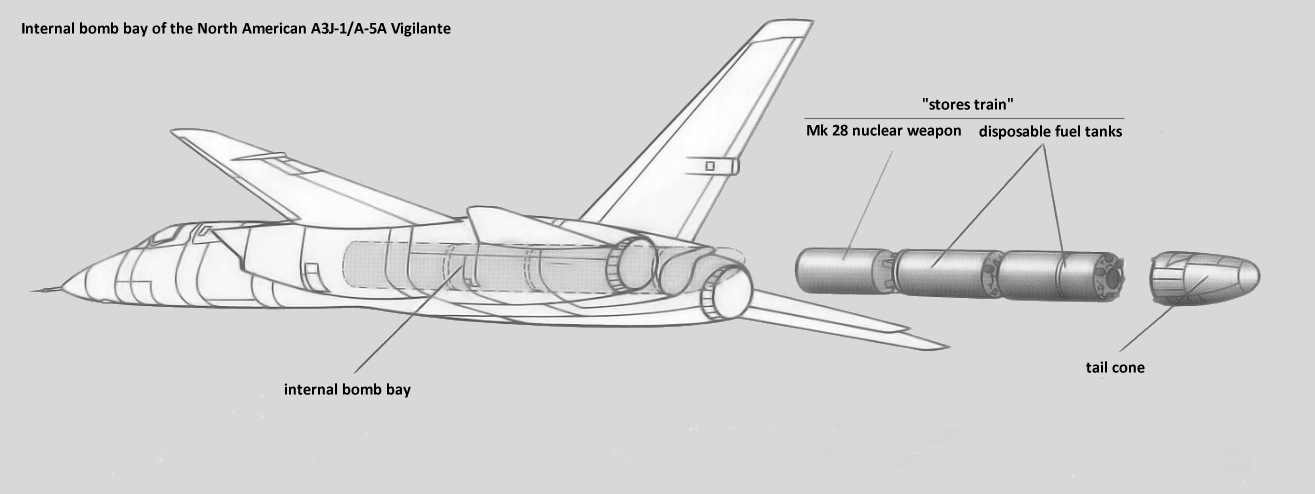
How can you not mention the A-5's weapons delivery system, wherein it basically poops a nuke out the back of the jet? All blurbs about the A-5, regardless of length should be required to mention the fact that it poops nukes.
 "ttyymmnn" (ttyymmnn)
"ttyymmnn" (ttyymmnn)
09/05/2017 at 11:38, STARS: 0
With limited space, I often rely on the expertise of my readers to fill in the gaps. Which you have done brilliantly. My thanks.